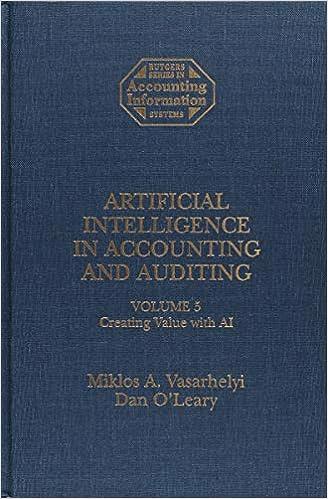Question
Subject: Accounting Info Systems Spring Rentals (SR) does business by leasing single-family homes and condominiums, minimizing the upkeep on them, and then renting them to
Subject: Accounting Info Systems
Spring Rentals (SR) does business by leasing single-family homes and condominiums, minimizing the upkeep on them, and then renting them to vacationers who want to spend a week to a few months on the Jersey Shore. The paragraphs below describe part of the acquisitions cycle for SR.
SR only deals in single-family houses in its home city, never in multiple unit dwellings. All homes away from home are houses leased from their present owners by SR employees who are called SR-agents. Lease contracts negotiated by these agents always deal with just one house, and the leases may last 3-5 years. All houses are in the same city and have unique street addresses. Every house is also given a single neighborhood designation by SR depending upon where it is located. Sample neighborhoods are West End, Elberon, the Heights (few SR houses), and the Depths (many SR houses). Those houses not associated with a traditional neighborhood are given a designation of either downtown or the outskirts, depending upon their location distance from the center of the city. Information on houses is not entered into the database until a lease for them has been contracted; however, information on neighborhoods is entered into the database as soon as SR determines that a new one exists (such as would happen when a new subdivision is being built). SR determines its ultimate rental rates to its summer customers by considering such matters as lot-size and number-of-bedrooms for each house, so it tracks data like that carefully. Additionally, each house is given a monthly rental surcharge which depends solely upon its neighborhood designation. These monthly surcharges range from very high (The Heights) to very low (The Depths), but every house has one associated with it, and all houses in a particular neighborhood have the same surcharge.
Many SR lessors own multiple houses which they lease to the company, but each house has only one owner. Payments to owners are not handled by SR-agents, but by cashiers who are actually a much duller class of employees than the flamboyant agents who revel in their ability to wheel and deal real estate at the expense of both owners and renters. Cashiers are bonded for security purposes, and cashiers never become agents (or vice- versa). Payments to lessors are done by checks which are drawn from company cash accounts. The check numbers used from each account are unique to that account, but they do duplicate across accounts (for example, there can be a check #100 drawn from account A-12 and another check #100 drawn from account A-16). There are some SR cash accounts from which checks are never written. Checks are also used to discharge other obligations of the company, such as advertising and taxes.
Checks are sent to lessors on a schedule determined by one of three lease payment options that are negotiated by the agents: (1) each month, (2) every six months, and (3) every year. Most leases do not require any kind of a payment at contract signing time. When multiple lease payments are due to the same lessor during the same month (because MSR is leasing more than one property from that person), cashiers simply disburse one check. Information concerning both employees and lessors is put into the database as soon as it is known without waiting for any transactions to take place.
REQUIRED: Using the information above and the list of attributes below (no additions), draw a UML Class diagram with classes, associations, attributes (with PKs designated), and multiplicities shown. The attribute in italics is an association hint and does not belong in a class object.

Step by Step Solution
There are 3 Steps involved in it
Step: 1

Get Instant Access to Expert-Tailored Solutions
See step-by-step solutions with expert insights and AI powered tools for academic success
Step: 2

Step: 3

Ace Your Homework with AI
Get the answers you need in no time with our AI-driven, step-by-step assistance
Get Started


